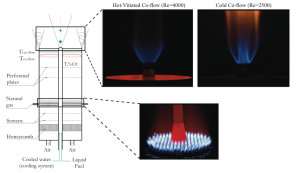Heavy Fuel Oil Combustion in a HiTAC Boiler
This project concerns the extension of the application of High Temperature Air Combustion (HiTAC) to heavy-oil combustion processes in a boiler. It is one of the projects of the Clean Combustion Concepts program of the Technology Foundation STW.
Objectives:
To generate the knowledge needed to be able to develop and design such a boiler, experimental and computational investigations will be made of turbulent spray flames under HiTAC conditions.
An experimental study of spray flames of light fuel oil burning in a co-flow of hot air diluted with combustion products will provide detailed knowledge of the relations between atomization process, ignition, entrainment and burnout.
A spray combustion model for the HiTAC regime will be developed for heavy fuel combustion, including the prediction of emissions under HiTAC conditions (NOx, CO and soot). This will provide a tool to assist in burner and boiler development. The spray model will be embedded in the commercial CFD code ANSYS-CFX and used in combination with appropriated models for turbulence, soot formation and radiative heat transfer.
This tool will be used to support the preparation of a HiTAC boiler field test. This field test will be done at 9 MW scale by Stork Thermeq, using heavy oil characterized and delivered by Shell. Stork will also develop water-steam cycles optimized for application in combination with HiTAC combustion.
Results experimental study of spray flames of light fuel oil
Flames with several combinations of spray and coflow conditions have been studied in detail, namely 1) ethanol reacting sprays in air and hot-diluted coflow, 2) ethanol reacting sprays in different hot-diluted coflow conditions, and 3) acetone and ethanol sprays in an identical hot-diluted coflow.
Detailed experimental studies have been made for spray flames of ethanol injected in coflow of cold air or of lean combustion products. As experimental techniques we used high speed camera and laser diagnostics (LDA for gas velocity, PDA for droplet size and velocity, and Coherent Anti-Stokes Raman Spectroscopy (CARS) for temperature). Combining the information obtained using all techniques the factors influencing spray flame structure could be identified. Trends with fuel injection pressure, with coflow oxygen concentration and temperature and with change of fuel composition, from ethanol to acetone, were studied.
The experimental datasets offer new opportunities for model validation. Its value comes from the combination of several features such as: challenging complexity, degree of completeness of the dataset for each single case and availability of several cases with different flame structure and liquid fuels.
PUBLICATIONS REPORTING RESULTS OF THE PROJECT
Journal publications
H. Correia Rodrigues, M.J. Tummers, E.H. van Veen, D.J.E.M. Roekaerts, Effects of coflow temperature and composition on ethanol spray flames in hot-diluted coflow, Int. J. Heat Fluid Flow, 51 (2015) pp. 309-323
dx.doi.org/10.1016/j.ijheatfluidflow.2014.10.006
Hugo Correia Rodrigues, Mark J. Tummers, Eric H. van Veen, Dirk J.E.M. Roekaerts, Spray flame structure in conventional and hot-diluted combustion regime, Combustion and Flame, 162 (2015) 759-773
dx.doi.org/10.1016/j.combustflame.2014.07.033
Shanglong Zhu, Dirk Roekaerts, Artur Pozarlik, Theo van der Meer, Eulerian-Lagrangian RANS model simulations of the NIST turbulent methanol spray flame, Combustion Science and Technology, 2015, in press
dx.doi.org/10.1080/00102202.2015.101961
H.R.C.Rodrigues and D.J.E.M.Roekaerts, Turbulent multiphase combustion, Ercoftac Bulletin 96 (2013) pp 18-23
Conference papers
S. Zhu, D.J.E.M. Roekaerts, and T.H. van der Meer, Numerical study of a methanol spray flame. 5th European Combustion Meeting, T. Griffiths (Ed.), Cardiff, UK, 2011, paper 067, 6 pages
S. Zhu, D.J.E.M. Roekaerts, and T.H. van der Meer, Numerical simulation of a turbulent methanol spray flame using the Euler-Lagrange method and the steady laminar flamelet model. In Proceedings of the Mediterranean Combustion Symposium. Chia Laguna, Sardinia, Italy, 2011
H. Rodrigues, M.J. Tummers, D.J.E.M. Roekaerts, Experiments on turbulent ethanol reacting sprays in HiTAC conditions, 12th International Conference on Liquid Atomization and Spray Systems, Heidelberg, September, 2-6, 2012
S. Zhu, D.J.E.M. Roekaerts, A.K.Pozarlik, B. Venneker, T.H. van der Meer, Numerical investigation towards a HiTAC condition in a 9MW heavy fuel-oil boiler, 6th European Combustion Meeting, Lund, Sweden, 25-28th June, 2013.
L. Ma, S. Zhu, H.R.C. Rodrigues, M.J. Tummers, T.H. van der Meer and D.J.E.M. Roekaerts, Numerical investigation of ethanol spray-in-hot-coflow flame using steady flamelet model, 8th Mediterranean Combustion Symposium, ÇeÅŸme, Izmir, Turkey, September 8-13, 2013, Paper EGTSC-13, 13 pages, Editors: Nevin Selcuk, Federico Beretta, Mohy S. Mansour, and Andrea d’Anna.Publisher: International Centre For Heat and Mass Transfer, METU, Ankara, Turkey
H.R.C.Rodrigues, M.J. Tummers, D.J.E.M. Roekaerts, Turbulent Spray Combustion in hot-diluted co-flow, 9th Asia-Pacific Conference on Combustion, Gyeongju Hilton, Gyeongju, Korea, 19-22 May 2013, 4 pp
H.R.C. Rodrigues, M.J. Tummers and D.J.E.M. Roekaerts ,Turbulent Spray Combustion of ethanol and acetone flames in flameless conditions, In: European Combustion Meeting – 2013 Paper P3-80, 6 pp, June 25-28, 2013, Lund, Sweden, ISBN 978-91-637-2151-9
H.R.C. Rodrigues, M.J. Tummers, E.H. van Veen, D.J.E.M.Roekaerts, CARS temperature measurements in ethanol reacting sprays in cold and hot-diluted coflow, In : Book of abstracts, 4th Workshop on the Turbulent Combustion of Sprays (TCS4), Çeşme, Izmir, Turkey, September 8, 2013, 1 page
PhD Thesis
Hugo R. Correia Rodrigues, Spray combustion in moderate and intense low-oxygen conditions: An experimental study. PhD Thesis, Delft University of Technology, 2015

Chair:
Fluid Mechanics
Involved People:
Dr.ir. M.J. Tummers
prof.dr. D.J.E.M. Roekaerts
Hugo Rodrigues